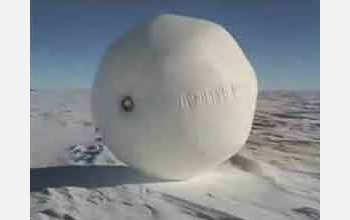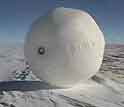|

Press Release 04-024
Rare "Tumbleweed" Survives Antarctic Conditions: Rover Designed to Seek Water in Ice Caps on Other Worlds

March 3, 2004
ARLINGTON, Va.—A balloon-shaped robot explorer that one day could search for water on other planets has survived some of the most trying conditions on planet Earth during a 70-kilometer (40-mile), wind-driven trek across Antarctica.
The Tumbleweed Rover, which is being developed at NASA's Jet Propulsion Laboratory (JPL) in Pasadena, Calif., left the National Science Foundation's Amundsen-Scott South Pole Station on Jan. 24, completing its roll across Antarctica's polar plateau roughly eight days later.
Along the way, the beach-ball-shaped device, roughly two meters (six feet) in diameter, used the global Iridium satellite network to send information about its position, the surrounding air temperature, pressure, humidity and light intensity to a JPL ground station.
The test was designed to confirm the rover's long-term durability in an extremely cold environment, with an eye toward eventually using the devices to explore the Martian polar caps and other planets in the solar system. It reinforces the findings of a test conducted previously on the Greenland ice cap, also carried out under the auspices of NSF's Office of Polar Programs (OPP).
OPP manages the U.S. Antarctic Program, arranging logistical support and infrastructure for NSF-supported scientists as well as other government agencies, such as NASA, when they conduct science in Antarctica.
NSF is an independent federal agency that supports fundamental research and education across all fields of science and engineering, with an annual budget of nearly $5.58 billion. NSF funds reach all 50 states through grants to nearly 2,000 universities and institutions.
The final Tumbleweed Rover is envisioned as a lightweight, roughly 40-kilogram (88 pound) device that can serve multiple roles as an independent robotic explorer. The rover's design allows it to act as a parachute while descending through an atmosphere, an air bag on landing, and, ultimately, as an unmanned vehicle equipped with an package of scientific instruments.
Tumbleweed is the brainchild of several JPL scientists, including Alberto Behar, a researcher with JPL's robotic vehicles group.
During a three-day deployment at the South Pole, Behar unpacked, assembled, inflated, tested, and deployed the rover. He says that the efficiency of the deployment is testament to Tumbleweed’ s cost-effectiveness and ease of use.
Even though the average external temperature during the rover's deployment approached minus 30 degrees Celsius (minus 22 degrees Fahrenheit), the rover kept its internal instrument payload at an average temperature of roughly 30 degrees Celsius (86 degrees Fahrenheit) using excess heat from the instrument electronics circulated by an air pump.
The ultra-durable ball reached speeds of 30 kilometers per hour (18.6 miles per hour) over the Antarctic ice cap, and traveled at an average speed of about six kilometers per hour (3.7 mph).
The winds at the South Pole were unusually low during the test. As a result, the rover did not move at all for several periods during its deployment.
But, even taking those lulls into account, Tumbleweed managed an average speed of 1.3 kilometers per hour (0.8 mph) over the course of the deployment. Such speeds are unattainable in conventional, mechanical rovers—such as Spirit and Opportunity, currently operating on the surface of Mars—which average little more than 0.05 kilometers per hour (0.03 mph) on flat, dry ground.
Behar said the rover's design is especially well suited for polar missions that use instrument packages to look for water beneath the surface of an ice sheet, a task that cannot be done accurately from orbit.
Plans to construct the next generation Tumbleweed rover are already underway at JPL.
Design refinements are likely to focus on reducing the rover's weight and rolling resistance to lower the minimum winds needed to propel the rover and enable it to travel farther and adapting the payload to include a ground-penetrating radar or magnetometer to conduct ice surveys.
Behar said he hopes an updated version of Tumbleweed will be deployed again in late 2004 or early 2005, and that the Tumbleweed design may one day find itself rolling over the polar icecaps of Mars.
-NSF-
B-Roll: For Betacam SP B-roll of NSF's Amundsen-Scott South Pole Station, including an animated locater map, please contact Dena Headlee, dheadlee@nsf.gov, (703) 292-7739
For a fact sheet on NSF's scientific logistics in the Polar Regions, see http://www.nsf.gov/od/lpa/news/media/01/fslogistics.htm
A JPL Web site contains information about previous tests of the Tumbleweed as well as animations of how the device might appear during a deployment on Mars, see: http://www.jpl.nasa.gov/technology/features/tumbleweed.html

Media Contacts
Peter West, NSF (703) 292-7761 pwest@nsf.gov
Natalie Godwin, NASA's Jet Populsion Lab (818) 354-0850 Natalie.Godwin@jpl.nasa.gov
Program Contacts
Vladimir Papitashvili, NSF (703) 292-8030 vpapita@nsf.gov
Principal Investigators
Alberto Behar, Jet Propulsion Laboratory (818) 687-8627 alberto.behar@jpl.nasa.gov

The National Science Foundation (NSF) is an independent federal agency that supports fundamental research and education across all fields of science and engineering. In fiscal year (FY) 2009, its budget is $9.5 billion, which includes $3.0 billion provided through the American Recovery and Reinvestment Act. NSF funds reach all 50 states through grants to over 1,900 universities and institutions. Each year, NSF receives about 44,400 competitive requests for funding, and makes over 11,500 new funding awards. NSF also awards over $400 million in professional and service contracts yearly.
 Get News Updates by Email Get News Updates by Email
Useful NSF Web Sites:
NSF Home Page: http://www.nsf.gov
NSF News: http://www.nsf.gov/news/
For the News Media: http://www.nsf.gov/news/newsroom.jsp
Science and Engineering Statistics: http://www.nsf.gov/statistics/
Awards Searches: http://www.nsf.gov/awardsearch/
| 


